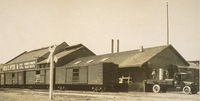George E. Hyde & Company
| Business |
Cannery |
|---|---|
| Main Location |
Campbell, CA |
| Aliases |
Hyde Cannery |
| Predecessors |
Campbell Fruit Growers Union |
Well-known cannery in Campbell, California. George Hyde bought the existing Campbell Fruit Growers' Exchange in 1915, and turned it into a modern cannery. The August 1921 Canning Age article highlights the cannery and the modern conveniences Hyde installed.
The cannery closed down after the 1928 season, with occasional restarts. Sunsweet eventually bought the property and used it for a large dryer and warehouse.
The buildings still exist and have been repurposed as offices and restaurants.
Locations
| Location | Years | Address | Details |
|---|---|---|---|
| Campbell | 1909, 1917, 1921, 1926, 1928 | Central Avenue | |
| West Side | 1900 | ??? | San Francisco Call 1900 list of dropoff locations for California Cured Fruit Association. |
Photos
George Hyde Cannery John C. Gordon Collection / San Jose Library
Hyde Cannery Bancroft Library, University of California, Berkeley
Details
Dried fruit processor and canner in Campbell from at least 1900 through the late 1920's.
George E. Hyde was listed in San Francisco Call 1900 list of delivery spots for California Cured Fruit Association on the "west side" of the Santa Clara Valley. According to Canning Age v2 #7 ( August 1921 the plant was constructed in 1892 for the Campbell Fruit Grower's Union. It was leased to George E. Hyde ("a co-partnership") in 1909, and operated as a dried fruit packing house. Canning started in 1915, and continued drying fruit on machinery on a mezzanine level.
Became associated with California Prune and Apricot Growers in 1917, packer for 1917 season.
October 1922 Western Canner and PAcker quotes Hyde as saying that business is September was the greatest ever for the company, and 90% of the "actual and prospective pack" in 1922 had already been sold. "The export business had been particularly gratifying to the company."
Cannery did not operate in 1930 according to July 9, 1930 San Jose Evening News and sold on the courthouse steps to American Trust in May 1932. Leased to Campbell Packing Corp. for one year according to April 22, 1933 San Jose Eveing News Sold to them in 1934.Sold to Sunsweet in 1937, became Campbell Cooperative Dryer.
According to September 14, 1933 Campbell Interurban Press article, the canning portion was being used by Sunsweet for warehousing (with canning equipment removed), and Higgins-Hyde leased the warehouse for storage and grading.
Campbell Historic Assessment also states that the site was occupied from 1887-1890 by Flemmings Fruit Dryer, then Frank Buxton's Dryer in 1890, then Campbell Fruit Growers Union in 1892.
Collection station for Sunsweet, 1917 acc. to July 21, 1917 San Jose Evening News list of Sunsweet collection stations.
George E. Hyde was born in 1855 in California, was a machinist foreman for the California Rolling Mills in 187x, and was married and had his first son in 1880 according to the census. The family lived at 225 Shotwell Street out in the Mission District. "Campbell the Orchard City" said he moved to Benecia in 1882, then to Saratoga in 1886. In 1900, he was listed as an orchardist. 1906 city directory shows him as a manager at Rosenberg Bros; he was manager when the Ryland Street plant burned on November 10,1906. A 1910 City Directory lists his residence as Prospect Road; George E. Hyde Company was a fruit packer near the SP depot, managing with R.K. Thomas. (R.K. Thomas shows up as owner of Campbell Realty in 1911.) Hyde died on June 27, 1933 after a long illness.
Hyde was active, shows up in San Francisco Call 1902 as part of improvement society trying to get railroad linking Cupertino to Mountain View, and represented San Jose Chamber of Commerce in visit to LA in 1903 according to December 17, 1903 San Francisco Call Hyde also did land development, such as the Alice Ave housing and the industrial area on Dillon. Warren Hyde was George E. Hyde's younger brother.
Canning Age v2 #7 ( August 1921 includes a nice detail piece on the workings of the cannery.
Great-grandson Jerry Hyde quoted in July 17, 2002 San Francisco Chronicle "Raised on Campbell ranch that his great-grandfather started... "
"In the early part of the 20th century, Hyde's great-grandfather George started the Sunnyside Ranch in Campbell, amassing hundreds of acres of apricots, prunes and peaches. By 1914, he had a cannery and drying yard to process his own fruit and others. The Southern Pacific Railroad track ran alongside, providing passengers, in season, with a captivating view of 25,000 fruit-drying trays."
"A progressive employer, Hyde built a cafeteria and social building for his workers and a day nursery and playground for their children. Hyde, the family historian, still has some of the vividly colored fruit labels and a panoramic picture of the cannery with employees in front."
"Like many others, the cannery business did not survive the Depression. Sunsweet, the growers association, owned it for some years. During the early 1960s, during Hyde's college years, the Santa Clara Valley began the transition out of agriculture that is virtually complete today. The former cannery now houses offices, but the original sign on the building remains."
Hyde Cannery may have been running in the 1928 season - a truck driver for the cannery was hit by a train according to the A August 28, 1928
